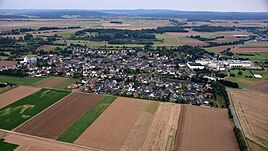Sinzenich
|
Sinzenich
City of Zuelpich
Coordinates: 50 ° 39 '36 " N , 6 ° 38' 53" E
|
|
|---|---|
| Height : | 175 m above sea level NHN |
| Area : | 4.46 km² |
| Residents : | 1252 (December 31, 2018) |
| Population density : | 281 inhabitants / km² |
| Incorporation : | 1st July 1969 |
| Postal code : | 53909 |
| Area code : | 02252 |
|
Sinzenich, aerial photo (2016)
|
|
Sinzenich is a district of Zülpich in the Euskirchen district in North Rhine-Westphalia . Mayor is Josef Heinrichs.
location
Sinzenich is located in the Zülpicher Börde . The Rotbach , Marienbach and Mühlenbach flow through the village . Other neighboring towns are Linzenich , Merzenich , Floren and Schwerfen . Sinzenich lies at 175 m above sea level. NHN . Run through the place
- the state road 178 ,
- the district roads 30 and 31 and
- the federal road 477 .
history
The Celts settled in Sinzenich around 3000 years ago . But there is also evidence of a Roman settlement. In 1897 a matron's altar belonging to Matronae Tummaestae was found. The St. Kunibert Church stands on the foundations of a “ villa rustica ”. This country house belonged to a Roman named Sentinius , from which the current place name is derived.
The first mention of Sinzenich can be found in a document from Otto I from the year 948. In 1031 Sinzenich had its own church. Today St Kunibert is one of the oldest buildings in the Rhineland . It is located in the center of the medieval town center and has an unusual shape. This was created by overbuilding a Roman villa with an early medieval hall church . The transverse rectangular tower was built around 1200 on Roman walls. The square choir, angled slightly to the east, dates from the first half of the 13th century. The nave was rebuilt around 1500. It has been a listed building since 1986 . A family of knights named themselves after the Sinzenich Castle , which already existed in the 13th century. Sinzenich was a subordinate rule in the Duchy of Jülich since 1500 . In 1895, the castle was struck by lightning and cremated by the resulting fire. Next to the old school there is a 15th century monastery in which first Franciscans , then nuns from Mariaweiler lived. Today part of it has been preserved as a residential building.
Schools existed in Sinzenich as early as 1600. In 1867 a school building was built, which was replaced in 1955. The school was expanded in 1997. A primary school is housed here. In the early 19th century there were eight cloth mills in the village. From one of these factories, today's Sinzenich paper mill emerged, which has been in operation as a branch of a large company for 150 years and recycles waste paper . A Jewish cemetery in Gartenstrasse still bears witness to the presence of Jews before the Second World War .
As a result of the municipal reorganization of the Euskirchen district, which came into force on July 1, 1969, Sinzenich belongs to the city of Zülpich.
Others
- There is the municipal kindergarten "Springmäuse" in the village .
- The largest employer in Sinzenich is the Tillmann paper mill, whose headquarters are in Sundern ( Sauerland ).
- Furthermore, the place has a medical group practice and a dentist .
- Until December 31, 2007 Sinzenich still had a "corner shop", which was replaced by the closure of "Heiko" s rolling markets. But there is still a butcher's shop with a bakery and café.
- The Raiffeisenbank has been closed for several years, the only company that is still managed there is the RWZ cooperative, but this will also be discontinued in the next few years.
Individual evidence
- ↑ Population figures as of December 31, 2018
- ^ Dorothea Eimert: St. Kunibert Sinzenich . 1st edition. Art Guide No. 1695 . Schnell & Steiner, Munich 1988.
- ↑ David Jung: Jews in Sinzenich, especially at the time of National Socialism. (Survey of contemporary witnesses, student thesis 2004, Franken Gymnasium Zülpich, revised 2012)
- ^ Entry on Sinzenich Jewish cemetery in the " KuLaDig " database of the Rhineland Regional Council , accessed on July 18, 2017.
- ↑ Martin Bünermann: The communities of the first reorganization program in North Rhine-Westphalia . Deutscher Gemeindeverlag, Cologne 1970, p. 88 .
Web links
- sinzenich.info (private website)
- zuelpich-sinzenich.de (private website)
- Hans-Dieter Arntz : Auschwitz survivors from Sinzenich - Jewish girls from Sinzenich near Zülpich survived Auschwitz (Shoah Testimony) (German Version)
- Hans-Dieter Arntz: Two forgotten and therefore preserved land synagogues in the Voreifel: Lommersum and Sinzenich
- Hans-Dieter Arntz: Memories of family, loss still clear for Holocaust survivor (English Version)
- Hans-Dieter Arntz: On the last traces of Jewish prayer in the Voreifel - The forgotten regional synagogues of Lommersum and Sinzenich




